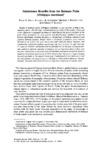Use este identificador para citar ou linkar para este item:
http://www.alice.cnptia.embrapa.br/alice/handle/doc/955767Registro completo de metadados
| Campo DC | Valor | Idioma |
|---|---|---|
| dc.contributor.author | MAY, P. H. | pt_BR |
| dc.contributor.author | ANDERSON, A. B. | pt_BR |
| dc.contributor.author | BALICK, M. J. | pt_BR |
| dc.contributor.author | FRAZÃO, J. M. F. | pt_BR |
| dc.date.accessioned | 2013-04-12T11:11:11Z | pt_BR |
| dc.date.available | 2013-04-12T11:11:11Z | pt_BR |
| dc.date.created | 2013-04-12 | pt_BR |
| dc.date.issued | 1985 | pt_BR |
| dc.identifier.citation | Economic Botany, v. 39, n. 2, p. 113-129, 1985. | pt_BR |
| dc.identifier.uri | http://www.alice.cnptia.embrapa.br/alice/handle/doc/955767 | pt_BR |
| dc.description | Stands of babassu palms (Orbignya martiana) occupy an area of Brazil estimated at nearly 200,000 km2, concentrated in the states of Maranhao, Piaui and Goias. Babassu's cryptogeal germination, establishing the apical meristem of the plant below ground for its early growth and development, enables it to survive human disturbance, making the palm an integral part of shifting cultivation and pastoral farming systems. People obtain a multitude of products from babassu throughout the palm's life cycle: leaves are used widely for thatch, basketry, and construction; trunks for palmito and bridges; the fruit for feed, oil and, charcoal. As many as 450,000 subsistence-level households rely on the sale of babassu kernels, used in a regional vegetable oil industry, for an important share of their cash incomes. Deforestation pressures and technological innovation toward an industry based on mechanical processing of whole babassu fruit threaten to reduce benefits the palm provides to the region's rural poor. Understanding how babassu is used by rural families who depend upon it will help to make current efforts at domesticating the palm and whole-fruit processing more responsive to human needs. | pt_BR |
| dc.language.iso | eng | eng |
| dc.rights | openAccess | eng |
| dc.title | Subsistence benefits from the babassu palm (Orbignya martiana). | pt_BR |
| dc.type | Artigo de periódico | pt_BR |
| dc.date.updated | 2013-04-12T11:11:11Z | pt_BR |
| dc.subject.thesagro | Babaçu | pt_BR |
| dc.subject.thesagro | Botânica | pt_BR |
| riaa.ainfo.id | 955767 | pt_BR |
| riaa.ainfo.lastupdate | 2013-04-12 | pt_BR |
| dc.contributor.institution | PETER H. MAY; ANTHONY B. ANDERSON; MICHAEL J. BALICK; JOSÉ MÁRIO F. FRAZÃO, EMBRAPA-UEPAE de Teresina, PI. | pt_BR |
| Aparece nas coleções: | Artigo em periódico indexado (CPAMN)  | |
Arquivos associados a este item:
| Arquivo | Descrição | Tamanho | Formato | |
|---|---|---|---|---|
| 7295.pdf | 1,79 MB | Adobe PDF |  Visualizar/Abrir |









